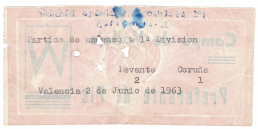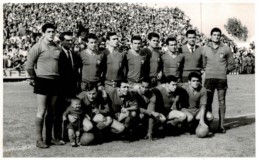Así a vuelapluma, Without looking too closely, the only explicit reference in this document is to the Estadio de Vallejo. It is unquestionable that this was an official match day at the Estadio de Alboraya. Levante faced the confrontation in local condition in the internal margins of its sports facility. The coat of arms that identifies the Valencian company occupies the central part of this entrance. Its owner, after signing the longed-for Portal de Vallejo, would follow the duel from the standing preference area. That space occupied one of the back sections of the granota coliseum. Football stadiums, since time immemorial, have always been characterised by their tendency towards social stratification by virtue of the location of their supporters.
We know that there was football in Vallejo, that is more than evidence, but we do not know the identity of the party. The date is not dated. In fact, in those years it was not customary to date each of the matches played at the entrance. There are no references to the lustre of the opponent. There is nothing to identify the confrontation in order to situate it in time and in its historical context. Perhaps this is a strategy of the institution to cut costs. It is much more expensive to situate the action of each match as a home game than to make up a generalised ticket for the whole season, and economic issues have always been burdensome within a sporting entity with a propensity towards deficit.
However, what seems to be an irresolvable hieroglyphic has a clear and diaphanous resolution. The owner of this ticket had the consideration and the good sense to fix his story, perhaps with the aim of perpetuating it in his memory and in the memory of Levantinism. On the back, with an old typewriter, he contextualised the nature of the duel. It was not a minor confrontation. “Promotion match to 1 Division” he set as the headline. “Levante – Coruña 2-1” appears as a pretitle. “Valencia 2 June 1963”. The information is copious. If there is any doubt, on the main side of the entry, on the upper band in felt-tip pen, there is a legend: “1 ASCENSO A PRIMERA DIVISIÓN 2 – JUNIO – 1963”.
Suddenly the ascendant of this entry mutates. Sixty years ago, Levante climbed to the sky of the Primera División. It was on the afternoon of Sunday 2 June 1963. That memorable day is still very much alive in the imagination of the Granotas’ supporters. Quique and Balaguer’s side battled against Lelé’s Coruña in the decisive match (2-1). The 1-2 defeat in the play-offs was a thing of the past. The Galician coach swapped the Vallejo bench for the Riazor stadium with the 1962-1963 season underway. The malevolent destiny guided him in the direction of the Levantine coliseum in the spring of 1963. The clashes took place in the framework of the Copa del Generalísimo and in the promotion/relegation promotion to the First Division. Levante came out unscathed from all the challenges against the Herculine team. The victories followed one after the other.
What happened on the green carpet of Vallejo on that memorable day is well known. The big bang materialised in the final minutes of the clash with Levante stalking the anchor of the Primera División. Serafín and Vall led a vigorous triumph that cauterised an old and deep wound. It was the third promotion for the Granota side. The fans went wild and stormed the pitch to solemnise their heroes. Nothing stopped a devastating explosion of feelings. Not even the battered state of Pope John XIII. That day there were no dykes to contain the emotion. Curiously enough, different scenes from that match served as illustrations for entries in the following year. The most obvious example is the ticket for the first derby in Vallejo. The snapshot seems to freeze the play of the second goal scored by Vall.


